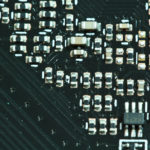 ROHM Semiconductor introduced their new thick-film shunt resistors, LTR100L, optimized for industrial and consumer applications. Often used to detect current in battery protection and motor drive circuits, shunt resistors require higher accuracy to improve reliability and ensure high-efficiency operation.
ROHM Semiconductor introduced their new thick-film shunt resistors, LTR100L, optimized for industrial and consumer applications. Often used to detect current in battery protection and motor drive circuits, shunt resistors require higher accuracy to improve reliability and ensure high-efficiency operation.
Recent years have seen an emphasis on energy savings in the industrial and consumer fields, with efforts being made to reduce power consumption during drive operation by using motor inverters. At the same time, protection circuits are becoming more important in these fields as applications continue to increase in power.
ROHM has been working on expanding its considerable lineup, most recently with the GMR320 series of metal plate shunt resistors, released in February 2021. The devices feature a higher guaranteed rated power of up to 10W. Since April 2018, ROHM has been producing the LTR50 series of low ohmic thick-film shunt resistors rated at 2W. With these latest products, ROHM has expanded its lineup of thick-film shunt resistors to support an even higher power area.
The LTR100L series achieves the industry’s highest-rated power of 4W in the 3264 sizes (3.2mm × 6.4mm) / 1225 size (0.12inch × 0.25inch) by revising resistor materials and applying terminal temperature derating. This makes them ideal for current detection in motor control and overcurrent protection circuits for industrial and consumer applications, which are progressing towards a higher power. In addition, optimization of the element structure delivers best-in-class TCR (temperature coefficient of resistance) characteristics among thick-film shunt resistors. As a result, they are not easily affected by temperature – enabling high accuracy, high-reliability current detection.
Samples can be purchased from one piece from online distributors Digi-Key, Mouser, and Farnell (starting with 10mΩ, 47mΩ, and 91mΩ). Furthermore, a variety of content and tools useful for design, such as application notes, are available on ROHM’s website. Simulation Models will also be released.







Leave a Reply